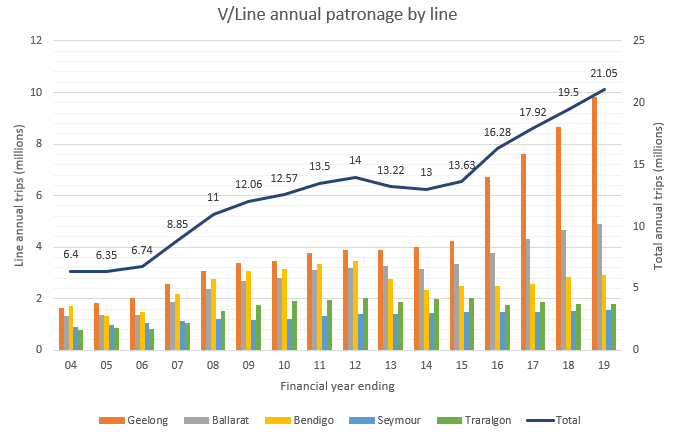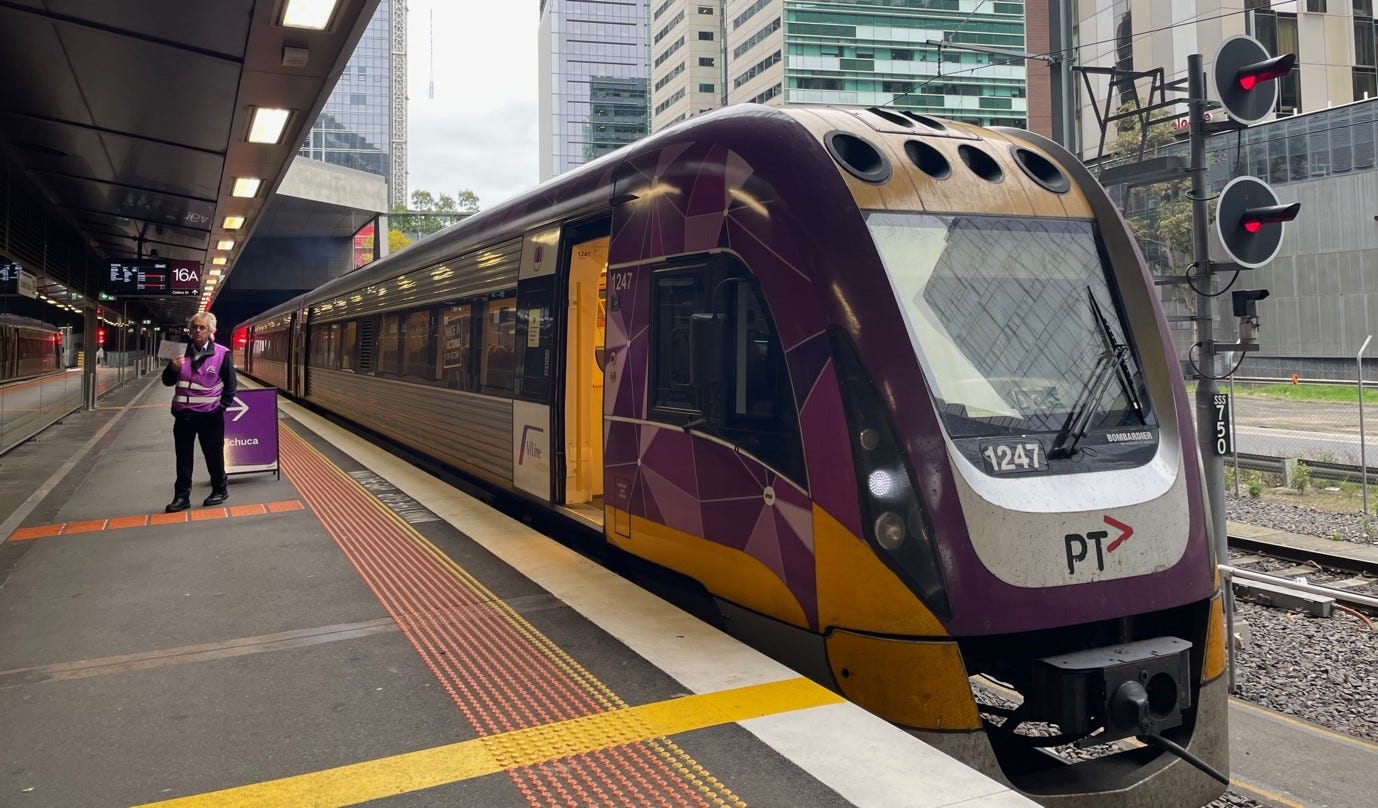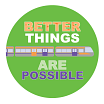Victoria’s Rail Revival – a Role Model for Aotearoa?
We have a long way to go with passenger rail in Aotearoa. In Australia, Victoria has rebuilt passenger rail over the past two decades. This can and should be a template for Aotearoa.
Railways were one of the great inventions of the Victorian era. They transformed mobility in Great Britain and the entire world, including Aotearoa, opening up vast new possibilities for business, interpersonal connections and enabling everyone to travel for leisure for the first time. This transformational power of rail was critical to the development of Aotearoa and, until the middle of the last century, connected virtually the entire country. However, since then rail was allowed to wither on the vine, subsumed by aviation and driving as the primary forms of mobility and the focus of government policy and investment.
Elsewhere, huge rail revivals have been going on over the past two decades, spearheaded by high-profile high speed rail networks in Europe and Asia; the revival of night trains in Europe and heavy investment in rail in a plethora of countries from Lithuania to Portugal to Norway. So clearly while rail, like the car, were Victorian inventions of the 19th Century, rail is as if not more relevant in the 21st Century as a tool of inclusive access and decisive climate action.
Closer to home, the state of Victoria in Australia has taken to the Victorian invention of rail with a vengeance in a multi-decade, multi-billion-dollar investment in regional rail that continues to this day. The so-called Regional Rail Revival started off at the turn of the century at a similar point to where Aotearoa is today. Rail had been subject to severe neglect and under-investment for decades and was in pretty poor shape.
The beginning: Regional Fast Rail
It started out in 2000 as the Regional Fast Rail Project. This $A750 million project, implemented in stages up to 2009, upgraded key sections of track to regional cities to enable 160 km/h running, improved train timetables and provided better integration with buses at regional cities for service to non-rail served communities. Record passenger numbers and a substantial contribution to the growth of regional Victorian economies have both been attributed to the project.
These infrastructure improvements were accompanied by a rolling stock revolution in the form of V/Locity trains. These 3-car Diesel Multiple Units have been in continuous production since 2003. Capable of 160 km/h running and large parts of the Victorian network now support these speeds enabling faster journey times. There are now 103 V/Locity trains in service and another 12 in production to support planned rail service improvements. The trains have comfortable seating with tray tables, have on-board toilets, and are quiet and smooth.
The Second Stage: Regional Rail Link
Building on the success of Regional Fast Rail, the $A3.65 billion Regional Rail Link Project, completed in 2015, built 47.5 kilometres of new railway through Melbourne’s western suburbs to separate regional trains from the Melbourne metropolitan network, thereby increasing rail capacity, speed and reliability for both urban and regional trains. For example, on the Geelong Line, this enabled 20-minute all-day trains on weekdays, and every 40-minutes at weekends with the last train leaving Melbourne at 1:15am as well as much improved services on the Bendigo and Ballarat lines.

The Third Stage: Regional Rail Revival
More recently, the 2017 Regional Rail Revival programme is investing $A4 billion in upgrades to every single Victorian regional rail line. This includes track upgrades, track duplication, new stations, station upgrades, new and extended passing loops and level crossing upgrades. But most importantly, this enables new communities to enjoy the benefits of regional rail and significant train frequency improvements. For example, on the Warrnambool Line, this will enable a fifth daily return train to Warrnambool, a town with a population of 35,743 as at the 2021 Census.
The Results
The results of all of this rail investment are impressive. Regional rail patronage has over tripled from 6.4 million in 2004 to 21.05 million in 2019. While the pandemic and Melbourne’s epic lockdowns took a severe toll on patronage, recent rail patronage data shows a strong rebound, reinforced by the Victorian government introducing in March 2023 a daily fare cap of $A9.20 ($A6.70 at weekends) for all public transport, including regional rail, across the entire state.

Key Elements
The key elements of the Victorian rail revival are a combination of bringing all of the elements of rail service together – frequency, reliability, speed, good quality trains and stations, price and network integration.
Frequency: Trains at least hourly all day, every day to major regional cities, several times daily elsewhere.
Reliability: Newer rolling stock and upgraded track means high service reliability.
Speed: Substantial sections of 160km/h running due to ongoing track upgrades means travel times competitive with or better than car travel.
Good quality modern trains and stations: Comfortable, well-designed trains and well-designed stations with good amenity.
Price: Daily fare cap of $A9.20 ($A6.70 at weekends) makes public transport much more affordable for everyone.
Network integration: Trains connect with feeder buses with time and fare integration to ensure seamless journeys across Victoria. The Myki card used for key regional rail journeys can also be used on all public transport in metropolitan Melbourne.
Regional cities with populations much smaller than Palmerston North, Tauranga and Hamilton have hourly train service to Melbourne, all day every day of the week. Every part of Victoria is connected by an integrated network of buses and trains, enabling access to business, access to work, access to healthcare, access to leisure, basically access to everything. The state of Victoria has a population of 6.8 million and pre-pandemic rail patronage of over 21 million. Aotearoa has a population of 5.1 million and inter-regional train patronage most likely in the low hundreds of thousands (there is no publicly available information for KiwiRail’s tourist-oriented rail journeys, so this is a rough guess).
Let’s be upfront about this. Turning back the clock on seven decades of systematic neglect of rail infrastructure and services didn’t come cheap for Victoria, nor will it be cheap for Aotearoa. But imagine for a moment what Aotearoa’s state highway network would look like if it had suffered a similar level of neglect as our rail network over the past seven decades – and how many tens of billions of dollars it would take to get it back to a fit for purpose quality of service. We wouldn’t accept that for a moment, nor should we accept it for rail.
Aotearoa has started this journey with the commitment in the 2023 budget to new passenger rolling stock for the Lower North Island, centred on the capital city of Wellington, analogous to Victoria’s early investment in rail to larger regional cities like Geelong from the state capital of Melbourne. Victoria has continued to build out from that initial investment that started over two decades ago. Aotearoa needs to do the same with the vision of building a national public transport network with regional and long-distance rail as its backbone.
“The question for Aotearoa is not whether we can afford to have a rail revival like Victoria’s but whether we can afford not to, given the climate emergency we are facing.”
The question for Aotearoa is not whether we can afford to have a rail revival like Victoria’s but whether we can afford not to, given the climate emergency we are facing. We need to provide kiwis with genuine transport choice the length and breadth of Aotearoa as a key tool in the battle to reach our statutory goal of net zero carbon emissions by 2050 and simply because providing inclusive access to all of Aotearoa, without needing a car or to be driven by others, is a fundamental human right and the right thing to do.







